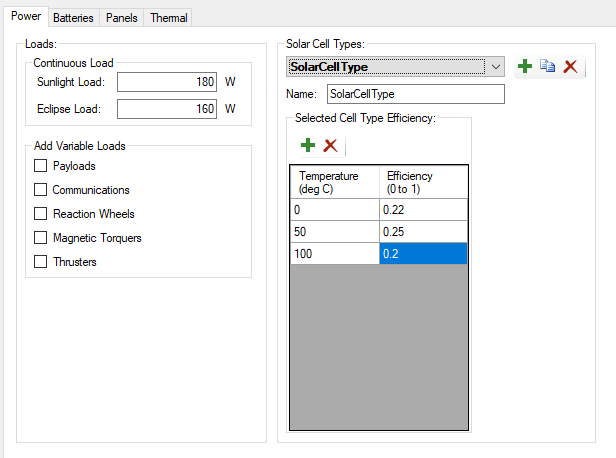Power
Use the Power tab to define loads and solar cell types for the power subsystem. For more information about power calculations, see the Power page.

Loads
Loads are defined to simulate systems that draw power from the power subsystem. Loads in SOLIS are broken up into two groups:
- Continuous: Defines load values for sunlight and eclipse conditions.
- Variable: Simulates dynamic power draw with additional loads from other systems.
Variable loads require you to define the external system correctly. In particular, most of the corresponding components have power parameters that you must define.
Loads parameter glossary
| Parameter | Description | Units |
|---|---|---|
| Sunlight Load | This is the load to consume when in sunlight (i.e., when the sun is not eclipsed by the central body). | W |
| Eclipse Load | This is the load to consume when the sun is eclipsed by the central body. | W |
| Payloads | If selected, this adds the payload power modeling as a power consumer. See Payloads for more details. | N/A |
| Communications | If selected, this adds the communications system power modeling as a power consumer. | N/A |
| Reaction Wheels | If selected, this adds reaction wheels power modeling as a power consumer and producer. See Reaction Wheels for more details. | N/A |
| Magnetic Torquers | If selected, this adds magnetic torquers power modeling as a power consumer. See Magnetic Torquers for more details. | N/A |
| Thrusters | If selected, this adds thruster power modeling as a power consumer. See Thrusters for more details. | N/A |
Solar Cell Types
Use the Solar Cell Types parameters on the Panels tab to define a panel's power generation efficiency. At least one solar cell type must exist for panels to be able to generate power. Only a single efficiency value is allowed unless you select thermal modeling.
Solar Cell Types parameter glossary
| Parameter | Description | Units |
|---|---|---|
| Efficiency | This is the solar cell efficiency, defined as how much solar energy hitting the cells is converted into power for the spacecraft. | 0 to 1 |
| Temperature | This is the temperature associated with a particular efficiency, and is only available if you select thermal modeling. | deg C |